Recent Indicator viewing

Indicator remains one of the finest companies putting out Blu-rays these days, supplementing everything from arthouse classics to popular entertainment to exploitation with copious contextual extras which can make even a throwaway movie interesting if not for its intrinsic qualities then for what it says about the genre it belongs to and the time and place it was made. Since context is one source of the pleasure I get from watching movies, I sometimes buy somethng that I may have no deep interest in because a disk reaches beyond the film itself and illuminates the commercial byways of the film industry. And sometimes, having come for the historical perspective, I discover something which turns out to have intrinsic interest on its own terms.

in Arthur Lubin’s Footsteps in the Fog (1955)
Footsteps in the Fog (Arthur Lubin, 1955)
Alfred Hitchcock’s Rebecca (1940) is generally considered the gold standard of romantic melodrama, but personally I prefer Thorold Dickinson’s Gaslight (1940), released just a few months after Hitchcock’s movie (and superior to George Cukor’s glitzy MGM remake from 1944). By the mid-’50s, these woman-in-peril movies, often with period settings, had come to seem old-fashioned and cliched, and Footsteps in the Fog (1955) passed without much notice. There was no real reason to expect much from it other than a chance to see husband-and-wife co-stars Jean Simmons and Stewart Granger emoting together in Edwardian costumes. Certainly, director Arthur Lubin didn’t inspire confidence – he was best known for a number of Abbott and Costello comedies and a series of B-movies starring Francis the Talking Mule. Granger almost backed out because he didn’t trust Lubin. But in the event, even if the direction is merely workmanlike, the movie turned out to be an intriguing variation on familiar themes.

The most interesting thing about it is the fact that the two stars play morally compromised characters, giving the story no hero or heroine to root for. Although they eventually pay for their transgressions as the Production Code demanded, the audience has been asked to root for someone whose actions are socially unacceptable. Right at the start, we learn that Granger’s Stephen Lowry is a villain; he has just buried his wife, his friends offering him their sympathy and support, when left alone he gives a huge satisfied smile that he has inherited the dead woman’s wealth. There’s more to his callousness, though.
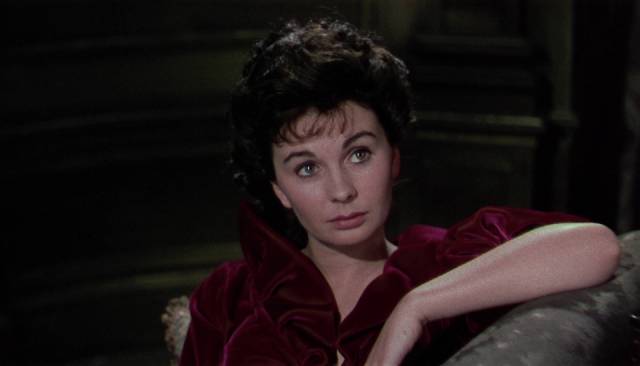
Housemaid Lily Watkins (Simmons) brazenly informs him that she knows that he poisoned his wife and she sets out to blackmail him, not directly for money, but rather for benefits which will raise her up from her lowly working class origins. The first step is to make her housekeeper, much to the disgust of cook Mrs. Park (Marjorie Rhodes), who is appalled that she’s to be placed under the authority of such an upstart. Lily’s new position allows her to insinuate her way more deeply into Lowry’s life, resentment building as she watches him begin a campaign to make Elizabeth Travers (Belinda Lee) his new wife, bringing him a new source of wealth.
Locked in an increasingly complicated psychological bond, with Lily pushing to become the new Mrs. Lowry herself, the pair become mutually destructive. Having clumsily tried to rid himself directly of his problem and inadvertently murdering another woman on a foggy night, Lowry devises a risky plan to slowly poison himself, implicating Lily. When his timing goes awry due to police intervention, he dies and Lily, guilty only of blackmail and lying to the police, finds herself arrested for murder.

The intricately constructed script – adapted by Dorothy Reid and Lenore Coffee from a W.W. Jacobs short story – is thick with irony and the intricacies of class conflict. Perhaps an English director might have made something more of the material, but Lubin is efficient enough and the quality of the writing shines through, while Simmons in particular gives a wonderfully nuanced performance.
The film looks very good on the disk, bringing out the atmosphere of Christopher Challis’ Technicolor photography and Wilfred Shingleton’s richly detailed production design. There’s an archival audio interview with Granger, and lengthy featurettes with Steve Chibnall on the career of Belinda Lee, Josephine Botting on cinema’s interest in post-Victorian England, and Katt Ellinger on the influence of the Gothic on the film.
*

Body Double (Brian De Palma, 1984)
I’m not sure why I revisited Brian De Palma’s Body Double (1984), a movie I felt a strong dislike for when I saw it during its original theatrical release. For some reason, it’s fairly highly regarded by his fans, but watching it again, I had the same reaction as before. I can see that he’s playing with form, as he so often has done in his work, calling attention to the artifice of filmmaking with a surprising degree of sourness – the industry is represented by cheap exploitation (the cheesy horror movie the protagonist is working on) and porn (in which the eventual heroine works) – and adding nastiness with a murder scene designed to mock criticism he had faced for the sexualized violence in many of his movies. When the killer impales his naked victim with a massively long power drill (the camera peering between his legs to hammer the phallic point home) you get the joke, but considering the horror of what’s being done to the woman, it’s really not funny.
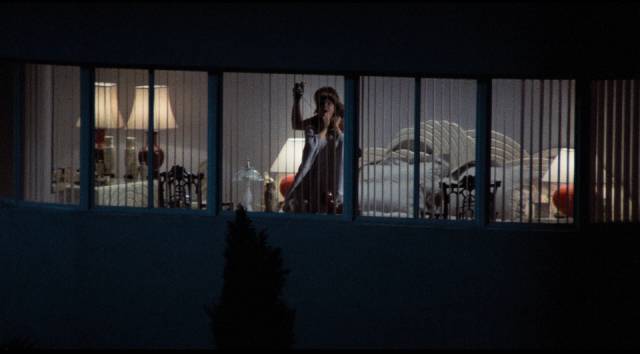
But what really defeats me is the protagonist, would-be actor Jake (Craig Wasson), who is kicked off the horror movie because his claustrophobia causes him to panic when his vampire character is confined to a coffin. That claustrophobia, like Scottie’s vertigo in Hitchcock’s 1958 film, is used by a manipulative man to facilitate the murder of his wife. But a bigger component of the plan depends on Jake’s unsavoury voyeuristic compulsion (turning Jeff’s interest in his neighbours in Hitchcock’s Rear Window [1954] into an unconcealed sexual perversion). Jake is a completely repellent character, so easily manipulated by the villain that the complications he becomes entangled with are more irritating than suspenseful.
The 4K image looks fine, and the disk is packed with featurettes and interviews. But I still don’t like the movie.
*

Experiment in Terror (Blake Edwards, 1962)
Maybe in the end it’s just a matter of taste, but I much prefer the more traditional approach to the thriller taken by Blake Edwards with Experiment in Terror (1962) than all the meta stuff De Palma piles on to justify the sleazy elements of Body Double. Edwards’ movie is taut and suspenseful, methodically putting its heroine through danger without reducing her to an object of exploitation.
Given Edwards’ later association with slapstick comedy, it’s easy to forget that he was equally adept at thrillers, creating the Peter Gunn series in the late ’50s, writing and directing for a number of other detective shows as well as occasional features, and Experiment in Terror remains one of his best – and stands the test of time better than so many of his more successful later comedies.

Lee Remick is bank teller Kelly Sherwood who, coming home from work one day, is threatened in her dark garage by an unknown man who tells her she’s going to help him rob the bank or she and her younger sister Toby (Stefanie Powers) will die. Terrified, Kelly nonetheless maintains control of herself and contacts the FBI. Under the guidance of agent John Ripley (Glenn Ford), she goes along with the man’s plans even though the risks increase. The plot generates suspense, but what really engages audience interest – and sympathy – is Remick’s terrific performance. Despite her justifiable fear, Kelly is not a victim, not a meek woman-in-peril, but rather an intelligent, self-possessed woman unwilling to cede her autonomy to a potentially violent criminal or to the methodical cop who uses her to trap the bank robber.

The script by husband and wife Gordon and Mildred Gordon, based on their novel, is well-constructed and Philip Lathrop’s black-and-white cinematography makes the most of the San Francisco locations. Glenn Ford knows that it’s Remick’s movie and limits himself to giving her solid support, while Ross Martin provides a creepy nemesis as the unsavoury criminal Red Lynch. The movie would make a great double Bill with J. Lee Thompson’s Cape Fear, made the same year.
The 4K transfer looks excellent, and there’s an interview with co-star Powers and a commentary by critic Kim Morgan.
*

in Richard C. Sarafian’s Fragment of Fear (1970)
Fragment of Fear (Richard C. Sarafian, 1970)
This early example of ’70s paranoia was made immediately before Richard C. Sarafian’s career high water mark, Vanishing Point (1971), but it lacks the clarity and single-minded intensity of that favourite. It’s not immediately clear what went wrong, given an excellent cast headed by the busy and popular David Hemmings and a script by Paul Dehn who had shown great skill in writing thrillers, having credits going back to the Boulting Brothers’ Seven Days to Noon (1950), Anthony Asquith’s Orders to Kill (1958), Guy Hamilton’s Goldfinger (1964), Martin Ritt’s The Spy Who Came in From the Cold (1965), Sidney Lumet’s The Deadly Affair (1967) and Anatole Litvak’s The Night of the Generals (1967). In a brief interview on the disk, however, assistant director William P. Cartlidge describes a chaotic shoot with a great deal of drug use and a somewhat disengaged director.

It’s too bad because there’s a lot to like in Fragment of Fear (1970). It just never comes together into a satisfying whole. Hemmings is Tim Brett, a recovering drug addict who has written a bestselling memoir about his experiences. Vacationing in Italy, he has befriended Lucy Dawson (Flora Robson), a woman who works for a charity which helps young criminals get back to a straight life. Having arranged to meet her in the ruins of Pompeii one afternoon, he discovers that she has been murdered. At the scene he meets Juliet Bristow (Gayle Hunnicutt, married to Hemmings at the time), and they begin a relationship.
Back in England, Brett begins investigating the organization Ms. Dawson worked for and finds himself getting drawn into mysterious schemes. He’s threatened – a strange woman he meets on a train later accuses him of sexual assault; at least that’s what a police sergeant tells him … but then it turns out that the sergeant doesn’t exist. Brett is pursued at night, cornered in an alley by men who plant a needle and drugs on him. He gets strange phone calls; someone breaks into his flat and leaves a message on his tape recorder; a threatening note turns out to have been written on his own typewriter. It all seems to add up to a vast conspiracy involving political corruption and an organization which uses the cover of the charity to exploit the young criminals supposedly being helped…

But then again, it may all just be the elaborate delusions of a former addict who has become detached from reality. In trying to maintain ambiguity, the film merely becomes irritatingly inconclusive, stubbornly resisting a resolution and ending up neither a satisfying conspiracy thriller nor a plausible study in the paranoia of a character damaged by his own past behaviour. Which is a pity, because individual scenes are often effective, the cast is packed with fine British character actors, and it’s beautifully shot by the great Oswald Morris … it just refuses to come into focus and ends up dissolving into nothing.
The disk image is excellent and in addition to the interview with assistant director Cartlidge, there’s a brief featurette on the career of writer Paul Dehn, who at the time was just embarking on creating the mythology of Planet of the Apes in a series of four sequels to Franklin Schaffner’s 1968 movie.
*
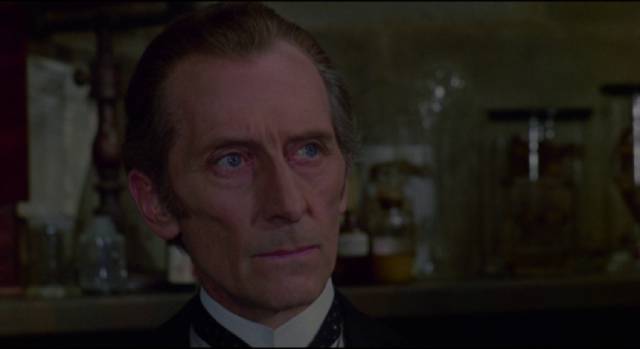
I, Monster (Stephen Weeks, 1971)
Stephen Weeks, who began precociously with a series of short films made in his late teens, was hired for his first feature when he was just twenty-two, but managed to put together only three more over the next decade, with a fourth collapsing part way through production despite a very high profile cast. It seems strange that an established company – in this case Amicus – would hire someone so young for what was intended to be a fairly prestigious feature, but Weeks got his shot at the big time with I, Monster (1971), working with veterans Peter Cushing and Christopher Lee.

The problem, though, was the company that hired him. Producer Milton Subotsky always fancied himself a writer, but it was often his scripts that kept Amicus productions from being much more than disposable entertainment. In this case, he set out to make “the most faithful and accurate adaptation of Robert Louis Stevenson’s The Strange Case of Dr. Jekyll and Mr. Hyde”. It does stick quite close to the novella, though it adds a more modern psychological gloss to the original’s more metaphysical view of good and evil – the doctor, a psychologist, creates his drug to free his patients from their inhibitions and repressed feelings. The oddest thing about the script, which generally plods its way through the familiar narrative, is that all the characters retain Stevenson’s names except for the main one(s), rechristened here Dr. Charles Marlowe and Mr. Edward Blake.
For Weeks as director, however, the biggest problem – and the one which tarnished his reputation right at the start of a potential career – was Subotsky’s decision to try and shoot the film in a fake 3D process which imposed major constraints on how it could be shot. Despite explanations provided in the disk supplements, I still don’t understand how it was supposed to work. No glasses were involved, but somehow alternate images were supposed to be sent to each eye and the illusion required constant lateral movement of the camera.
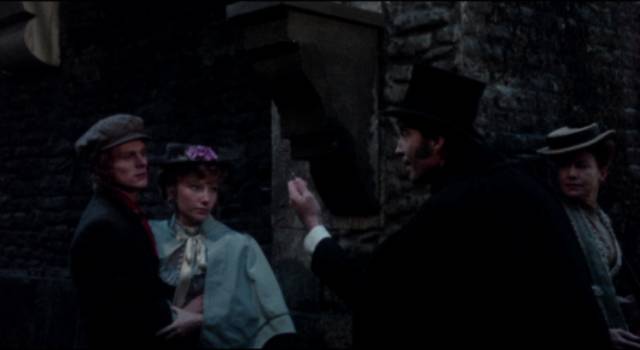
This plan explained something which puzzled me as I was watching; Weeks frequently makes unmotivated sideways movements (left to right) which drag the pace to a crawl as we watch walls and objects drift by while waiting for the story to continue. There’s an utterly bizarre shot in a pub as the camera tracks left to right following characters having a conversation as they push past the customers standing at the bar – it’s completely unnatural and distracting. All of this would make you think that Weeks didn’t know how to direct, but he was actually following his producer’s demands. Realizing that the phony 3D was never going to work, he quietly dropped it part way through production and just got on with the job … something which displeased Subotsky, who deemed the film a failure partly because, as he saw it, Weeks just wasn’t capable of doing what was necessary to make the “3D” work.
Apart from the stylistic awkwardness which resulted, it’s the redundancy of yet another version of the story – just a month before it was released, Hammer had mocked the idea with Roy Ward Baker’s Dr. Jekyll and Sister Hyde – that defeats it. In many ways, it has a similar feel to Terence Fisher’s The Two Faces of Dr. Jekyll (1960), an atmospheric period setting, a solid cast, a bit of sadistic violence … but nothing new to say. It doesn’t help that Lee’s Mr. Hyde is made up like a character from a TV comedy show, more silly than scary.
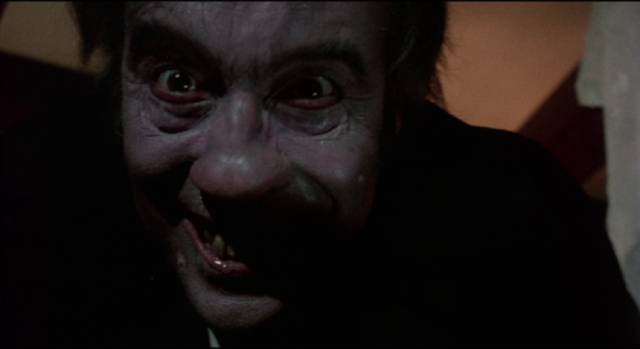
Of Weeks’ subsequent three completed features, two were versions of the story of Sir Gawain and the Green Night (1973, 1984), which I haven’t seen, but the third is by far his most interesting work – Ghost Story (1974), a languid, atmospheric story set in an English mansion in the 1930s where past and present merge and unhappy secrets are brought to the surface when a group of friends gather together. I just ordered a copy of Nucleus’ Blu-ray (an upgrade from their excellent two-disk DVD from 2009) and look forward to seeing it again.
Despite I, Monster being such a minor work, Indicator has stacked the disk with extras, including two different cuts, two commentaries with Weeks (2005, 2020), a lengthy audio interview with Subotsky from 1985, an audio interview with editor Peter Tanner, a featurette with score composer Carl Davis, an introduction by author Stephen Laws and a conversation between Weeks and Laws at a film festival in 1998.
*

in Max Ophuls’ The Reckless Moment (1949)
The Reckless Moment (Max Ophuls, 1949)
To be honest, I know far less about the work of Max Ophuls than I probably should. I think my first encounter with his work was seeing a restoration of Lola Montes (1955) in London in 1984 (though I may have seen La Ronde [1950] on television before that). I remember it being visually ravishing but dramatically enervating, the conceit of the famous Lola ending her life as a circus attraction becoming a heavy-handed metaphor for 19th Century celebrity which reduces her to a visual cipher virtually devoid of personality. But given the film’s reputation I could very well be entirely mistaken – I’ll find out when I receive the Editions Filmmuseum DVD I just ordered (which contains the alternate German-language version which Jonathan Rosenbaum deems superior to the French one filmed simultaneously).
As a German Jew, Ophuls left Germany for France in 1933, continuing the career he had only just begun a year or two earlier, making more than a dozen movies before going into exile again when France fell to the Germans in 1941. Making his way circuitously to the United States he remained idle as a filmmaker until after the war, when he got a chance to direct The Exile (1947), a swashbuckler starring Douglas Fairbanks Jr. and Maria Montez. Ophuls followed this with three more films in two years before returning to France; these were romantic melodramas not fully appreciated at the time, although later critics regard them highly, not necessarily for their content so much as for their style.

Here’s the potentially embarrassing confession: I haven’t actually seen either Caught or Letter from an Unknown Woman (both 1948), but his final American film, The Reckless Moment (1949), I’ve seen three times, including most recently on Indicator’s Blu-ray. I think this is largely because the material appeals to me more than either of the others. And that material, I first encountered in Scott McGehee and David Siegel’s remake, The Deep End (2001), starring Tilda Swinton. I haven’t seen that again since its theatrical release, so I can’t compare the two films as adaptations of the same novel (by Elizabeth Sanxay Holding) – the remake adds a twist by replacing the daughter with a gay son. Ophuls’ film, though, is one of the finest examples of what might be called “domestic noir”, a riveting female-centred nightmare of oppressive middle class life in post-war America.
Lucia Harper (Joan Bennett) is the backbone of what appears to be an exemplary family living in a small community just outside Los Angeles. A dutiful wife and mother, her role is to hold things together against the forces which might send the family spinning off in different directions. Husband Tom (Henry O’Neill) is frequently away on long business trips; teenage son David (David Bair) disdains propriety by messing around with car engines and going shirtless in the driveway: and 17-year-old daughter Bea (Geraldine Brooks) is determined to break free of what she feels is a stifling life. To this end, she has started an affair with an older man in L.A., Ted Darby (Sheppard Strudwick).

The film opens with Lucia meeting Darby in a closed bar, telling him to stay away from Bea. He says he will if Lucia gives him some money. By the time she drives home, determined to tell Bea what a heel the guy is, he has already called Bea and told her Lucia tried to buy him off – and the girl naturally believes him rather than her mother. But when she meets him surreptitiously one night in the boathouse, he tells her he really could use some money. Offended, Bea pushes him away and runs back to the house. Unseen by her, he staggers, falls through a railing and lands on the beach below, impaled on a small anchor.
When she discovers the body early next morning, Lucia goes into fierce protective-mother mode. She takes the body out in a small boat and carries it away to a swamp down the coast. Unfortunately, the body is found quite quickly and a murder investigation begins. But there isn’t much to connect the family to this petty criminal. At least, not in the eyes of the police. However, someone else knows about Bea and Darby, and that someone has love letters from Bea to prove it. Loan shark Nagel (Roy Roberts) sends his partner and henchman Martin Donnelly (James Mason) to demand that Lucia hand over $5000 or the letters will go to the police.

There are two main points of interest in the way the narrative unfolds. The first, and perhaps most conventional, is the developing relationship between Lucia and Donnelly; a man with his own unhappy past and dissatisfaction with where he’s ended up in life, he sees the family’s middle class existence as something desirable yet unattainable and he quickly finds himself attracted to Lucia’s strength and determination to protect that existence – even on his first visit to the house to deliver Nagel’s ultimatum, he’s visibly uncomfortable, embarrassed to be dragging something dirty into this home. And he falls in love with her, trying to find ways to avert Nagel’s threat, to protect her from the sordid world in which he himself lives.
Parallel with this, however, we see the darker underside of the life he’s idealizing. Backbone of the family she might be, but Lucia has virtually no social and economic power. Pushed to deliver the extortionist’s “fee”, she has no real access to money beyond what her much-absent husband provides as an allowance for household expenses. She tries to pawn her jewellery and is taken advantage of, given far less than their value because she’s in no position to bargain. She goes to a loan company – “no questions asked, no collateral needed” – and finds herself asked extremely intrusive questions, required to provide her husband’s permission.

There is really no economic solution to the bind she’s in and in the end she’s saved only by the man who has come to love her; Donnelly turns against Nagel and sacrifices himself, even taking on responsibility for Darby’s death. For all that her marriage to Tom gives her social status, Lucia is utterly dependent on men for her security; even a lowly, disreputable man like Donnelly possesses more real power than she does.
The Reckless Moment is a fascinating dissection of the intersection of class and gender in post-war America cast in the form of film noir blended with romantic melodrama. The finely constructed script and excellent cast – Bennett and Mason were never better – are enhanced by Ophuls’ renowned stylistic touches, his staging and fluid camera creating a visual analogue for the film’s themes, clearly delineating the separate social spaces inhabited by the characters – even the ground floor and upper floor of the house carry different weights, as do the house and the boathouse, the beach facing a peaceful cove and the streets of the city. Lucia has constantly to navigate the differing yet intersecting demands of these spaces while holding together the persona which she’s forced to inhabit as middle class wife and mother.
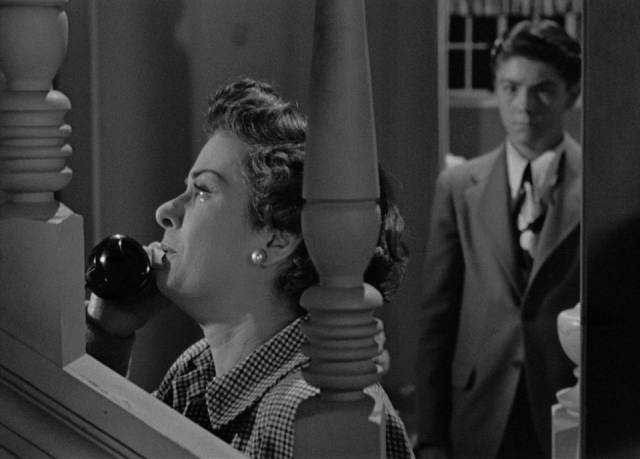
The Indicator Blu-ray looks terrific, the image much improved over the old Second Sight DVD from 2006. The cinematography of Burnett Guffey is restrained compared to many noirs, maintaining a naturalistic approach which suits the domestic setting. Extras amount to almost three hours, with an interesting account of the production and Ophuls’ American work from Lutz Bacher, plus two lectures and a Q&A focused on James Mason. Filmmaker Todd Haynes delivers an appreciation of what, not surprisingly, is one of his favourite films.
*
Next: A pair of Indicator box sets.
*
The queue:
I have a bad tendency to shelve unwatched disks and then forget about them as new stuff comes in, so it was a bit of a shock to see just how many Indicator titles have been gathering dust while I watch more recent acquisitions. Some of these have been waiting an embarrassingly long time for me to get around to them, while others arrived recently because of yet another on-line sale.
Box sets:
Five Tall Tales: Budd Boetticher and Randolph Scott at Columbia (an upgrade from the excellent Sony DVD set released in 2008)
Samuel Fuller at Columbia 1937-61
Deluxe Editions:
Sweet Charity – 3 cuts of Bob Fosse’s first feature
The Last Movie – extras-packed restoration of Dennis Hopper’s controversial second feature
Scum – extras-packed edition of Alan Clarke’s feature remake of his banned BBC drama
The rest, a mix of upgrades and new acquisitions, including old favourites and movies I haven’t previously seen – and in some cases hadn’t even heard of:
Alan Parker’s Birdy
Cavalcanti’s They Made Me a Fugitive
Michael Winner’s The System
Jack Garfein’s The Strange One
Melvin Van Peeples’ Watermelon Man
Bill L. Norton’s Cisco Pike
Lindsay Anderson’s Britannia Hospital
Jiri Weiss’ 90 Degrees in the Shade
J.L. Anderson’s Spring Night Summer Night
Anthony Page’s Absolution
Roger Corman’s The St. Valentine’s Day Massacre
Peter Mullan’s Orphans
Jack Ckayton’s The Pumpkin Eater
Dick Clement’s Otley
Charles Crichton’s The Third Secret
Matthew Chapman’s Hussy
Richard Loncraine’s The Missionary
Arthur Penn’s Mickey One
Jack Gold’s The National Health
Peter Medak’s A Day in the Death of Joe Egg
Tony Richardson’s The Border
Michael Powell’s Age of Consent
Silvia Narizzano’s Georgy Girl
John Dexter’s The Virgin Soldiers
Nicolas Roeg’s Track 29
Joseph Losey’s Eve
Comments